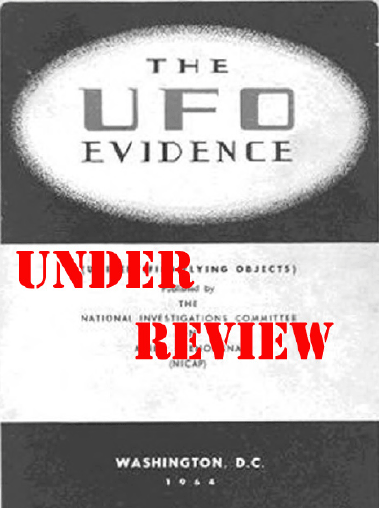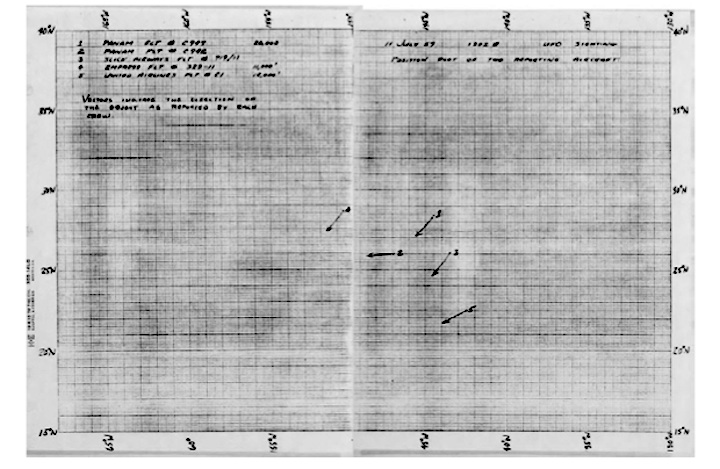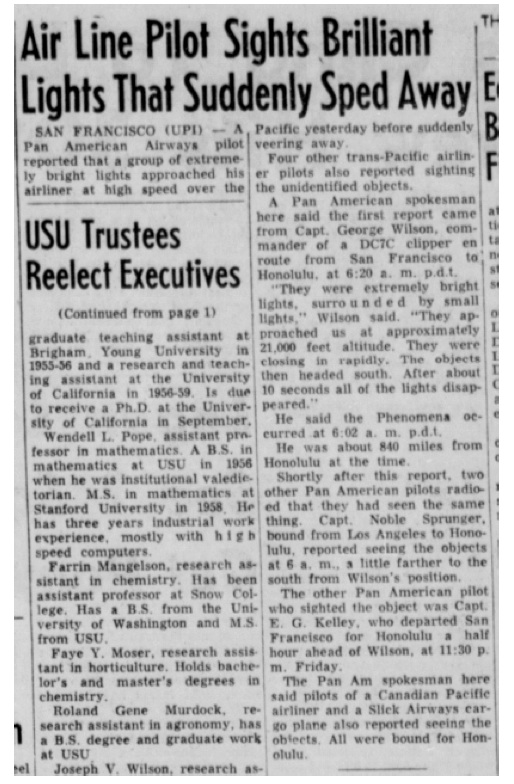.

July 11, 1959
NICAP summarizes the event in their chronology:
July 11, 1959--Pacific Ocean, 900 miles NE of Hawaii. Pan American Airways crews, other pilots, watched UFO with satellite objects make sharp turn. [X]1
Section X gives us the following testimonies:
Capt. George Wilson, Pan American Airways, gave the following account: “While fly- ing a Boeing Stratocruiser at 20,000 feet on a 224 degree heading [about 900 nau- tical miles northeast of Honolulu] a large and bright light appeared on the horizon at 11 o’clock position [58W]. The large bright light was flanked by 3 or 4 smaller low- er magnitude lights in a line below, behind and to the left of the main vehicle. The lights passed from 11 o’clock to 10 o’clock position, the formation made an abrupt right turn and disappeared to the south.”
The co-pilot, Richard Lorenzen, and Flight Engineer Bob Scott, also saw the UFOs. Lorenzen commented that “the rate of closure with us was much greater than any I had ever experienced before. It was not until the object turned that I was able to distinguish the smaller lights associated with it.”
First Officer D. W. Frost, on another Pan American flight in the vicinity, reported es-
sentially the same phenomenon. The UFOs were also observed by Air Force bomber crews, a Slick Airways plane, and a Canadian Pacific airliner. Capt. Lloyd Moffait, pilot of the Canadian airliner, told the press: “You can take it from me they were there. I never saw anything like it in my life and there are four of us who saw the same thing at the same time.”2
NICAP reports they were unable to interview the Air Force crews as to their accounts of the event. A look at the Blue Book file might present those interviews as well as other information not obtained by NICAP.
Blue Book’s investigation
Missing from much of the NICAP report were specifics that should have been stated. For instance, how long was the event? What time was the event? Had they presented that information, the even would have sounded less impressive. The actual time of the event was around 1300Z. For the pacific ocean, near Hawaii, this is GMT -10 or -9 or about 0300-0400 local time. The sun had not risen indicating it was still dark. More important was the duration of the event, which was, according to Blue Book, only 3-15 seconds depending on the observer.
Unlike NICAP, Blue Book chose to plot the positions of the aircraft and directions of observations. The end result indicated they were looking at something very far away and not close. 3
.

The data from the sighting indicates this was probably a bright fireball that had fragmented. The actual trajectory was probably a straight line and the pilots simply misperceived the apparent change in direction.
Explained?
The evidence suggests that the source of the sighting was possibly a bright fireball and not an alien spaceship. NICAP listed this
4
event because of the “reliable witnesses” involved in the sighting and because it appeared in the media . The one thing that
has been learned about UFO reports over the past sixty years is that there is no such thing as a “reliable witness” and people can mistake ordinary events, like fireballs, as exotic ones. With the case having a probable explanation, it should be removed from the “Best Evidence” list.
Notes and references
-
Hall, Richard M. (Ed.) The UFO evidence. The National Committee on Aerial Phenomena (NICAP). New York: Barnes and Noble. 1997. P. 138.
-
ibid. P. 125.
-
“11 July 59 1302Z UFO sighting positional plot of the reporting aircraft”. Fold 3 web site. Available WWW: https://www.fold3. com/image/8407366 and https://www.fold3.com/image/8407368
-
“Air line pilot sights brilliant lights that suddenly sped away”. The Herald Journal. Logan, Utah. July 12, 1959. P. 3

- Quelle: SUNlite 4/2016
